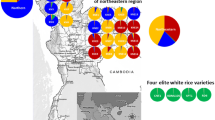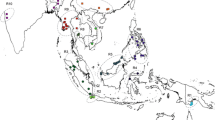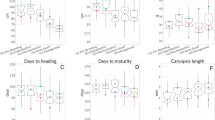Abstract
Australian wild rice (Oryza sp.) diverged in isolation from the progenitors of cultivated rice millions of years ago and is likely to harbour novel alleles of value to rice breeding programs. Since the separation from Gondwana 100 MYA, Australia has been characterised as a primarily dry continent with nutrient-impoverished soils. This has led to speculation that alleles conferring tolerance to nutritional deficiency and other abiotic stresses such as drought or heat may be present within Australian wild rice germplasm. Previous genetic studies suggested that representative ex situ accessions of O. meridionalis and O. rufipogon are distinct from Asian wild rice but the variation in morphological or nutrient stress traits within the Australian wild rice germplasm collections has not been investigated. We therefore characterised 14 key morphological traits at flowering and maturity in five O. meridionalis ex situ genetic resource accessions in comparison with representatives of O. rufipogon, O. australiensis, O. officinalis and the O. sativa mega-variety IR64. The results were consistent with genetic analyses that indicate O. meridionalis and O. rufipogon are closely related. Variation in tolerance to phosphorus deficiency, a major nutritional constraint to global rice production, was identified among Australian wild rice accessions, although at the phenotypic level this did not appear to exceed levels of tolerance present in the O. sativa mega-variety IR64. More detailed genetic analysis may establish whether this has been achieved through convergence of distinct loci and alleles or whether recombination between the distinct lineages may generate novel transgressive levels of tolerance. We conclude that subsequent collections of Australian wild rice should be guided by underlying geological, topographical and other long-term environmental features which indicate locations known to be P deficient or exert selection pressure for adaptations to other abiotic stresses including salinity or drought stress.





Similar content being viewed by others
References
Atwell BJ, Wang H, Scafaro AP (2014) Could abiotic stress tolerance in wild relatives of rice be used to improve Oryza sativa? Plant Sci 215:48–58
Brar DS, Khush GS (1997) Alien introgression in rice. Plant Mol Biol 35:35–47
Bremer B, Jansen RK, Oxelman B, Backlund M, Lantz H, Kim K-J (1999) More characters or more Taxa for a robust phylogeny—case study from the coffee family (Rubiaceae). Syst Biol 48(3):413–435
Burkitt LL, Moody PW, Gourley CJP, Hannah MC (2002) A simple phosphorus buffering index for Australian soils. Aust J Soil Res 40:497–513
Chen LJ, Lee DS, Song ZP, Suh HS, Lu BR (2004) Gene flow from cultivatedrice (Oryza sativa) to its weedy and wild relatives. Ann Bot 93:67–73
Gamuyao R, Chin JH, Pariasca-Tanaka J, Pesaresi P, Catausan S, Dalid C, Slamet-Loedin I, Tecson-Mendoza EM, Wissuwa M, Heuer S (2012) The protein kinase Pstol1 from traditional rice confers tolerance of phosphorus deficiency. Nature 488:535–539
Giuliani R, Koteyeva N, Voznesenskaya E, Evans MA, Cousins AB, Edwards GE (2013) Coordination of leaf photosynthesis, transpiration, and structural traits in rice and wild relatives (Genus Oryza). Plant Physiol 162:1632–1651
Heath TA, Hedtke SM, Hillis DM (2008) Taxon sampling and the accuracy of phylogenetic analyses. J Syst Evol 46(3):239–257
Henry R, Rice N, Waters D, Kasem S, Ishikawa R, Hao Y, Dillon S, Crayn D, Wing R, Vaughan R (2010) Australian Oryza: utility and conservation. Rice 3:235–241
Ismail AM, Heuer S, Thomson MJ, Wissuwa M (2007) Genetic and genomic approaches to develop rice germplasm for problem soils. Plant Mol Biol 65:547–570
Jacquemin J, Bhatia D, Singh K, Wing RA (2013) The International Oryza Map Alignment Project: development of a genus-wide comparative genomics platform to help solve the 9 billion-people question. Curr Opin Plant Biol 16:147–156
Jones GPD, Jessop RS, Blair GJ (1992) Alternative methods for the selection of phosphorus efficiency in wheat. Field Crop Res 30:29–40
Julia C, Dingkuhn M (2012) Variation in time of day of anthesis in rice in different climatic environments. Eur J Agron 43:166–174
Juliano AB, Naredo EB, Jackson MT (1998) Taxonomic status of Oryza glumaepatula Steud. I. Comparative morphological studies of New World diploids and Asian AA genome species. Genet Resour Crop Evol 45:197–203
Koide Y, Pariasca-Tanaka J, Rose TJ, Fukuo A, Konisho K, Yanagihara S, Fukuta Y, Wissuwa M (2013) QTLs for phosphorus-deficiency tolerance detected in upland NERICA varieties. Plant Breed 132:259–265
Krishnan SG, Waters DLE, Henry RJ (2014) Australian wild rice reveals pre-domestication origin of polymorphism deserts in rice genome. PLoS ONE 9(6):e98843
Lambers H, Finnegan PM, Laliberté E, Pearse SJ, Ryan MH, Shane MW, Veneklaas EJ (2011) Phosphorus nutrition of proteaceae in severely phosphorus-impoverished soils: Are there lessons to be learned for future crops? Plant Physiol 156:1058–1066
Ng NQ, Hawkes JG, Williams JT, Chang TT (1981) The recognition of a new species of rice (Oryza) from Australia. Bot J Linnean Soc 82:327–330
Orians GH, Milewski AV (2007) Ecology of Australia: the effects of nutrient-poor soils and intense fires. Biol Rev 82:393–423
Prevostia FJ, Chemisquy MA (2010) The impact of missing data on real morphological phylogenies: influence of the number and distribution of missing entries. Cladistics 26:326–339
Raymont GE, Lyons DJ (2011) Australian laboratory handbook of soil and water chemical methods. Inkata Press, Port Melbourne
Rose TJ, Wissuwa M (2012) Rethinking internal phosphorus utilization efficiency (PUE): a new approach is needed to improve PUE in grain crops. Adv Agron 116:185–217
Rose TJ, Rengel Z, Ma Q, Bowden JW (2007) Differential accumulation patterns of phosphorus and potassium by canola cultivars compared to wheat. J Plant Nutr Soil Sci 170:404–411
Scafaro AP, Haynes PA, Atwell BJ (2010) Physiological and molecular changes in Oryza meridionalis Ng., a heat-tolerant species of wild rice. J Exp Bot 61:191–202
Slavich PG, Sinclair K, Morris SG, Kimber SWL, Downie A, Van Zwieten L (2013) Contrasting effects of manure and green waste biochars on the properties of an acidic ferralsol and productivity of a subtropical pasture. Plant Soil 366:213–227
Sotowa M, Ootsuka K, Kobayashi Y, Hao Y, Tanaka K, Ichitani K, Flowers JM, Purugganan MD, Nakamura I, Sato YI, Sato T, Crayn D, Simon B, Waters DLE, Henry RJ, Ishikawa R (2013) Molecular relationships between Australian annual wild rice, Oryza meridionalis, and two related perennial forms. Rice 6:26
Sweeney M, McCouch SR (2007) The complex history 248 of the domestication of rice. Ann Bot 100:951–957
Vaughan DA (1994) The wild relatives of rice. A genetic handbook. International Rice Research Institute, Manila
VSN International (2014) GenStat for windows, 16th edn. VSN International, Hemel Hempstead. Web page: GenStat.co.uk
Wang ZY, Second G, Tanksley SD (1992) Polymorphism and phylogenetic relationships among species in the genus Oryza as determined by analysis of nuclear RFLPs. Theor Appl Genet 83:565–581
Waters DLE, Nock CJ, Ishikawa R, Rice N, Henry RJ (2012) Chloroplast genome sequence confirms distinctness of Australian and Asian wild rice. Ecol Evol 2:211–217
Xu JH, Kurata N, Akimoto M, Ohtsubo H, Ohtsubo E (2005) Identification andcharacterization of Australian wild rice strains of Oryza meridionalis and Oryza rufipogon by SINE insertion polymorphism. Genes Genet Syst 80:129–134
Author information
Authors and Affiliations
Corresponding author
Rights and permissions
About this article
Cite this article
Julia, C.C., Waters, D.L.E., Wood, R.H. et al. Morphological characterisation of Australian ex situ wild rice accessions and potential for identifying novel sources of tolerance to phosphorus deficiency. Genet Resour Crop Evol 63, 327–337 (2016). https://doi.org/10.1007/s10722-015-0252-4
Received:
Accepted:
Published:
Issue Date:
DOI: https://doi.org/10.1007/s10722-015-0252-4




